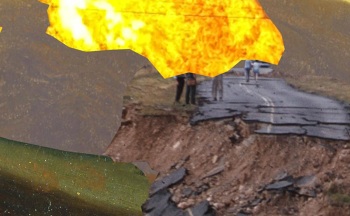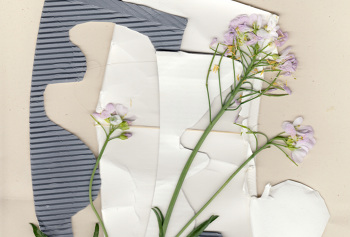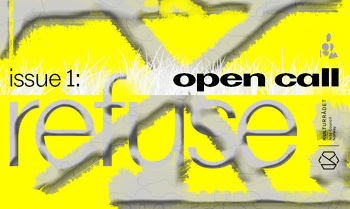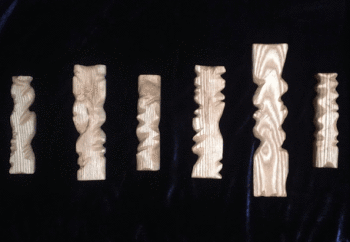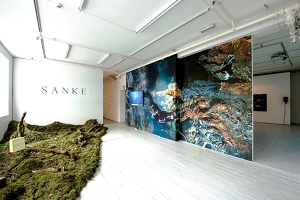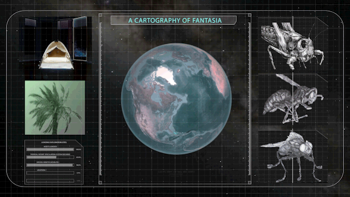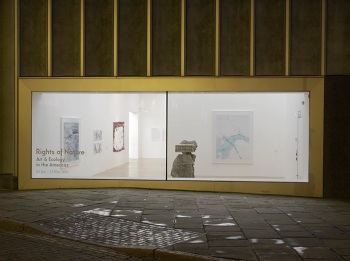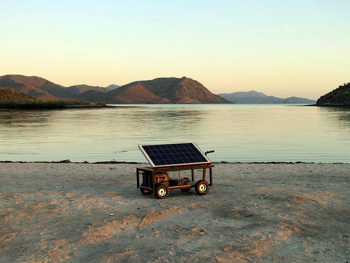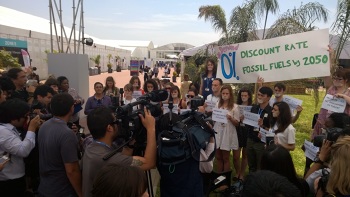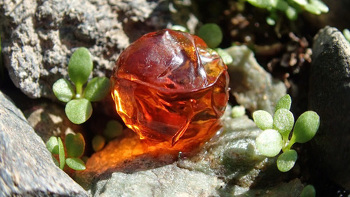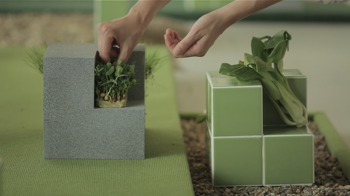Decade Zero: Art in Climate Action, an exhibition by Ben Yau and Žaneta Zukalová
[16/10/17]
Decade Zero: Art in Climate Action is an exhibition by Ben Yau and Žaneta Zukalová, whose works approach the role of art amongst the sociopolitical tensions of petrocapitalism and global environmental deterioration. Addressing public, corporate and governmental agencies, the show tackles the broader challenges of varied responses and responsibilities to climate change. The project will expand online as Decade Zero: Environment and Art Matters, and Worm’s meets up with Ben and Žaneta to find out more.
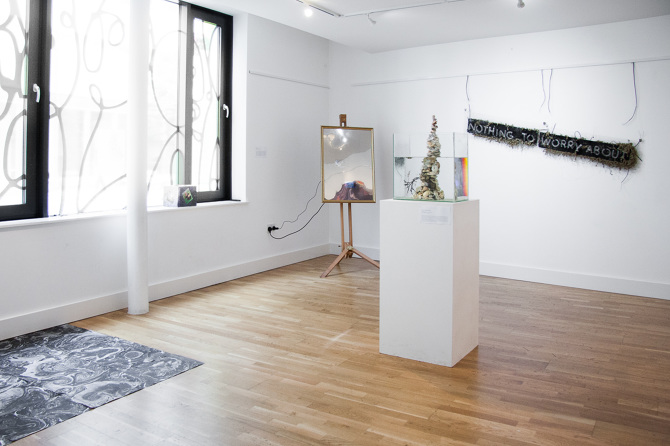
Decade Zero, exhibition view Greenwich West Gallery
Decade Zero: Art in Climate Action positions art as an activistic negotiator between the public and governmental understanding of the climate crisis. How do you define the parameters and scope of political art, its responses or responsibilities, to act against global environmental collapse?
Žaneta Zukalová: Art has the power to coherently articulate and visualise environmental issues to the public. Through aesthetic means, it can be appealing enough to engage people with such dense and intensive topics such as fossil fuels industry, ocean acidification etc. Although there is no doubt that climate scientists have a deeper knowledge of their research and study, artists can take and translate this research into a visual language that is easier for people to understand.
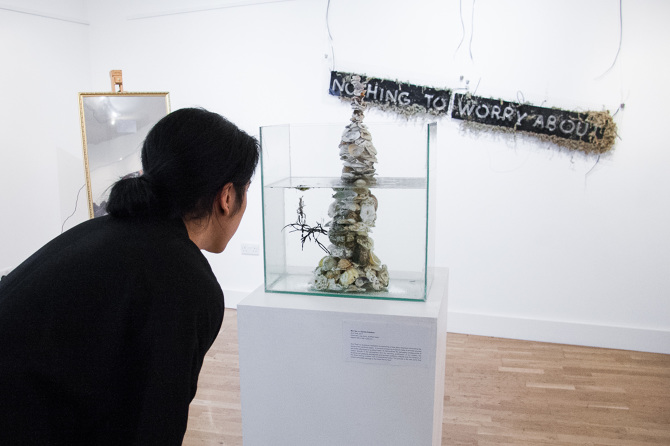
Ben Yau and Zaneta Zukalova
Acid Tank, 2017
Glass tank, sea shells, acidified water Approx 450 x 430 x 260 mm
However, political/activist artworks often tend not to be specific enough in terms of their appearance, and thus, unless it is studied, the artwork loses its capacity to explain, educate and inspire. To give an example, the concepts of Felix Gonzales-Torres’s art are extremely interesting, elaborate, and sociologically important to address, but whom is it actually for? If you choose to convey the topic of social injustice, should it be not serving a wider society rather than a limited circle of people already familiar with the topic or coming from the sphere of art? We want to contribute in order to spread the notion of community action. So the vision is to educate people and make them aware of the power they hold together as a community; to act and to change what is needed in order to make the world work better.
On the other hand, Joseph Beuys’s political engagement was indisputably one of the most visible and straightforward within the artworld. He managed to interact with people in a comprehensive and effective manner. He talked to his audience in person, discussing politics and possible solutions to various social injustices. His message was clear, radical and inspiring and that is what our aim is as well.
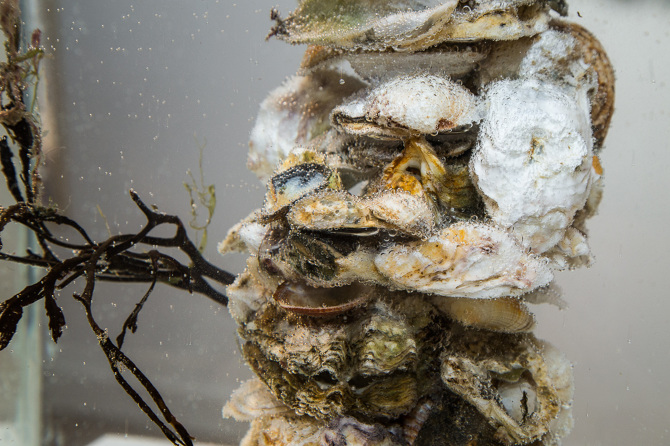
Ben Yau and Zaneta Zukalova
Acid Tank, 2017
Glass tank, sea shells, acidified water Approx 450 x 430 x 260 mm
Ben Yau: There are boundaries to what political art can and cannot achieve to act against such injustices as global environmental collapse. As we can learn from the political art produced by artists in response to the Vietnam War in the 1960s, or the numerous collectives who sparked action against the AIDs crisis in the 1980s, political art can be argued to be a catalyst to real change, by sparking political action. However – to borrow an idiom from the collective, Gran Fury – in many ways, “art is not enough”. Political art, as opposed to activist art, exists in physicality within an art institution, and therefore, adopts or even promotes the deficiencies that come from many of these institutions.
For example, art galleries mostly are, and largely have always been, exclusionary and elite spaces. What came as a realisation to me was that many art galleries do a pretty dire job of inviting the community that they exist within, as Zaneta already mentioned. And of course we must consider the funding that British museums receive from the fossil fuels industry. How can artists challenge extractivism within such institutions, when they so heavily cherish the oil money that they receive? Beyond this, how can artists challenge neoliberal ideas within institutions if they rely on funding from multinational corporations? There are many reasons to oppose arts funding from fossil fuels, but one reason that is not discussed enough is that it impairs artists’ abilities to challenge such industries.
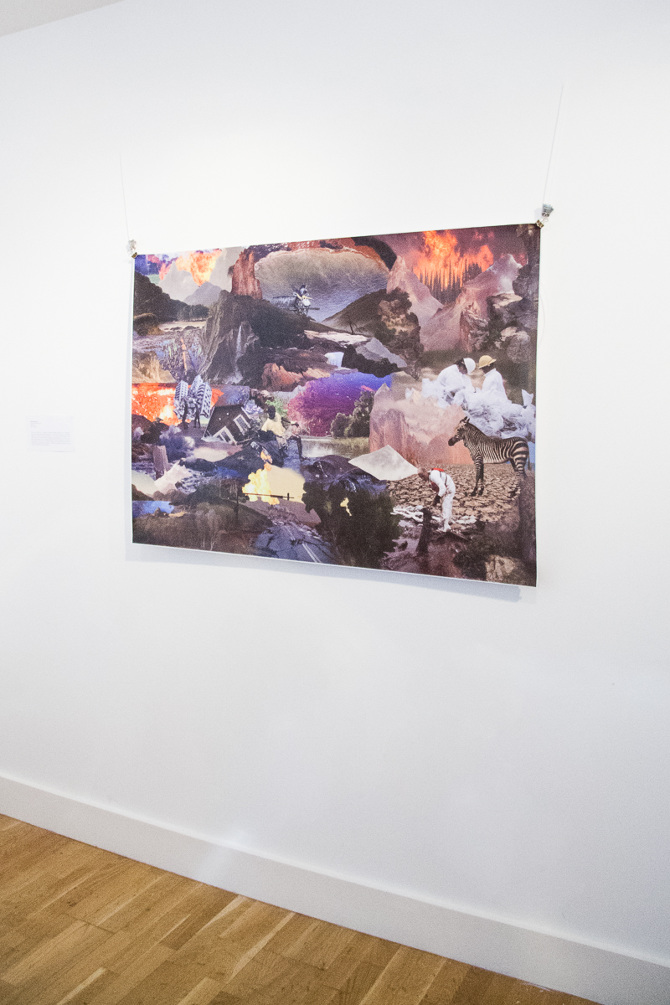
Zaneta Zukalova
Evolve and Destroy, 2017 Inkjet print
841 x 1189mm
Despite the challenges for artists in the current climate, we discovered ways to circumnavigate these issues. For example, what we realised when seeking a space to host our exhibition is that an inclusive, public community and art centre such as Greenwich West was a more appropriate environment than a large or commercial gallery. We also consciously elaborated on the artworks by placing contextual descriptions on labels in plain English, in order for visitors, many of whom will not have art or philosophy degrees, to benefit from the artwork. Such creative solutions can be viewed as artistically distasteful to some, but it is up to contemporary artists to challenge the status quo in order to improve it.
How do the artworks in the exhibition engage with the multifaceted subject, from climate science to cultural responses, policy-making to activist resistances?
BY: All of the artworks go beyond only demonstrating environmental damage. From the beginning, we were aware of the frictions and correlations between deregulated markets and oil spills; domestic disasters and remote commercial practices; environmental policy and crony capitalism. We wanted to demonstrate many of these connections.
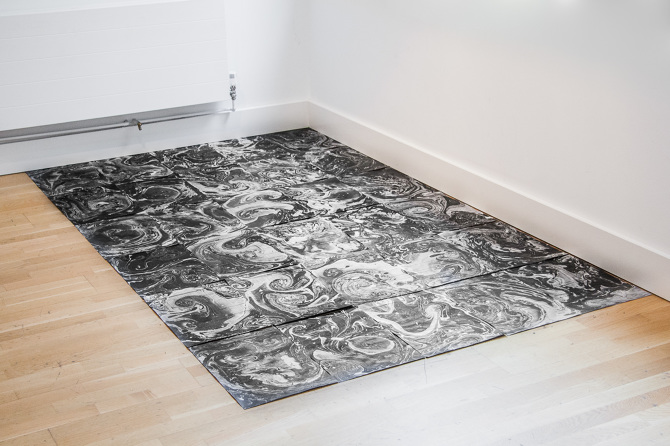
Ben Yau
Oil Spill, 2017
Oil based ink on laser printed paper 30 prints of 297 x 420 mm
One artwork, titled Oil Spill (2017), dominates a corner of the floor space, and confronts the viewer with thirty pages of market data collected from the Financial Times archive, that correspond by date to thirty oil spill events in the past five years. The artwork makes use of a traditional marbling technique of floating oil-based inks on top of water, with an alteration of using this printed market data instead of plain paper to capture the ink. In this way, the aqueous patterns created by the floating black ink “recreate” the oil spills, while becoming part of the base data material. By doing this, I wanted to convey that such disasters at frequency should not be viewed without considering the deregulated economic system that allows oil companies to extract. Just like the tragedy of Grenfell Tower, oil spills are largely avoidable disasters that are manifestations of corner cutting and penny saving, which is in turn integral to under-regulated industries.
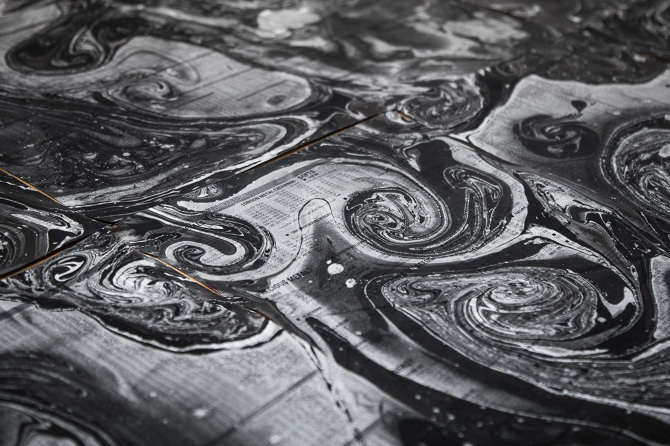
Ben Yau
Oil Spill, 2017
Oil based ink on laser printed paper 30 prints of 297 x 420 mm
ZZ: Also, we wanted to point out the geographical proximity and near presence of climate change. For instance, in my work called Welcome Home (2017), I drew on the correlation between the fossil fuel industry and the notion of home. From gas fracking and its subsequent leak into the domestic water systems, to the compulsory purchase order of wetlands that the Sompeta people depend on for vital crops, fossil fuels can no longer be considered a remote problem. On the contrary, they have become a household issue globally. The most fragile and worst affected areas are still those near the coast such as Bangladesh, Sudan, Caribbean and Siberia, yet paradoxically they are the least responsible for carbon emissions. Welcome Home consists of a series of videos placed behind one-way mirror, depicting various environmental corruptions. It exploits the reflective act of looking into a mirror, thereby putting the spectator in the position of participant rather than passive observer.
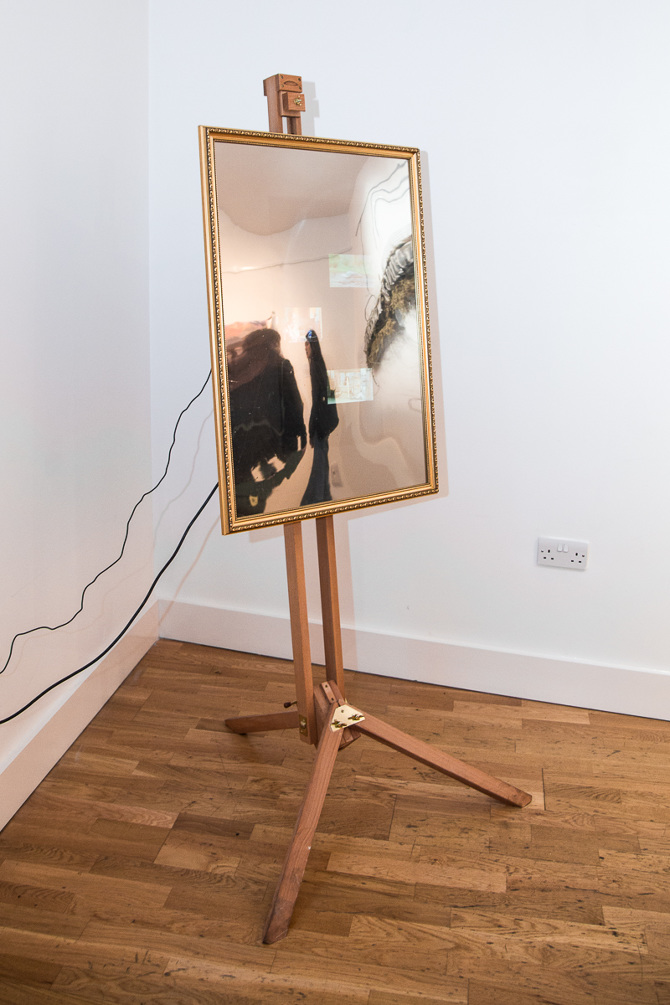
Zaneta Zukalova
Welcome Home, 2017
Video, one way mirror, frame, monitor 594 x 841mm
You are also showing a short film "Forget Shorter Showers" by the artist and independent filmmaker Jordan Brown. What kind of political action does he call for and how does this perspective augment the discussions you hope the exhibition can stir?
BY: The film scrutinises and puts into perspective individualistic "solutions" to environmental issues such as composting or shorter showers, and articulates why it is not an alternative to real, political action.
ZZ: It also explains why the fossil fuels lobbyists want people think that these personal solutions are an effective way to deal with climate change, while disregarding the fact that carbon emissions from industry far outweigh the pollution caused by municipal use. The film uses the words of Kirkpatrick Sale, an independent scholar and author who has written about environmentalism and political decentralism:
For the past 15 years the story has been the same every year: individual consumption — residential, by private car, and so on — is never more than about a quarter of all consumption; the vast majority is commercial, industrial, corporate, by agribusiness and government [he forgot military]. So, even if we all took up cycling and wood stoves it would have a negligible impact on energy use, global warming and atmospheric pollution.
Finally, the film provides alternative and real solutions, which it sees in collective direct action, such as organising, protesting, and lobbying.
BY: I would like to add to this by highlighting the importance of systemic change through environmental policy. When discussing solutions to climate change with a friend, they brought up some recent research into how dispersing crushed up diamonds into the sky could reflect light and heat away from the Earth. What was amazing to me was that, to this intelligent individual, shooting diamond dust into the sky was somehow more feasible than divesting from fossil fuels and introducing a tax on carbon emissions. It conveys the sheer lack of optimism we can have when it comes to challenging the neoliberal system; we can sooner imagine a blanket of diamonds in our stratosphere than reasonable measures that detract and divest from corporate interests.
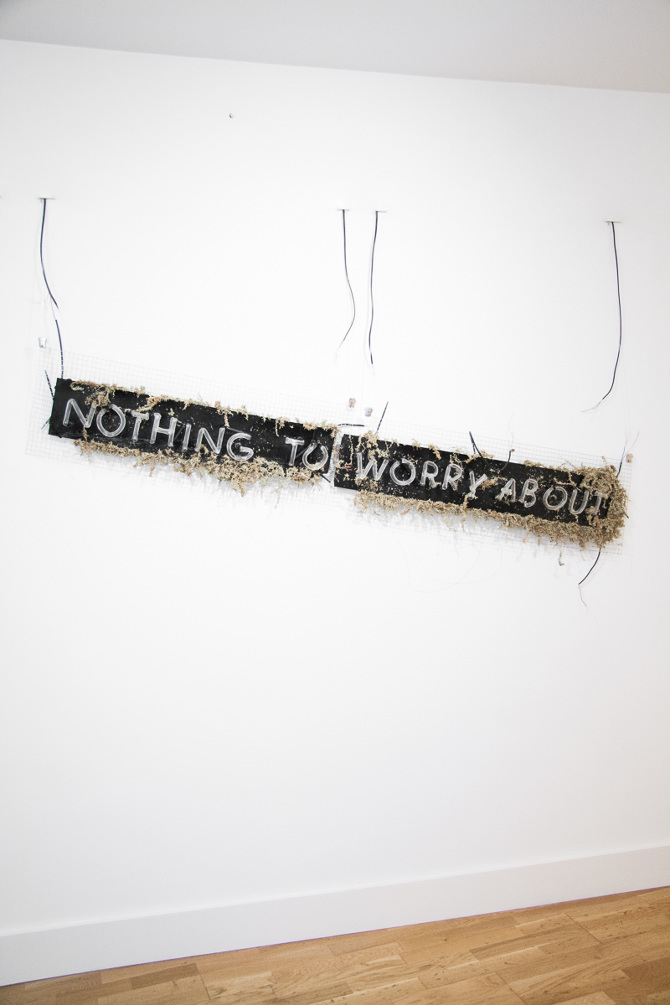
Ben Yau
NOTHING TO WORRY ABOUT, 2017
Acrylic tubing, perspex sheet, steel mesh, moss Dimensions variable
Decade Zero opened with a diverse programme of expression on environmental issues, including a talk, film screening, poetry and sound performances. Tell us more about this event and how they inform the various concepts of the exhibition.
BY: Once we established a time and place for the exhibition opening, we decided to put out an open call for performers addressing many of the issues discussed. An important factor was to have voices from a diverse range of backgrounds as well as a multi-disciplined approach.
ZZ: To be exact, we had six performers, all reflecting on climate change from a different perspective: Brandon Ra Pestano read out a few of his poems where he made a point on the relation of capitalism to the environment. Caleb Adebayo, a lawyer and founder of an environmental nonprofit Earthplus in Nigeria sent us his video response to the issue of climate change from the point of view of local people, who are one of the worst afflicted. Sophie Marsh and Leo May contributed with a short film Americas exploring the ‘the emotional and physical consequences of our disassociation with nature’. We included two artists who use music as their means: sound artist Luc Wilkinson created a special piece corresponding to our exhibition and Chris Wilson played three songs reflecting on the correlation of changing climate – changing society. Scientist and science communicator Dr. Lyle Zimmerman gave us a very comprehensive and striking talk on the issue of ocean deoxygenation. Overall, it was an engaging and diverse set of performances uniting like-minded people from various artistic fields together.
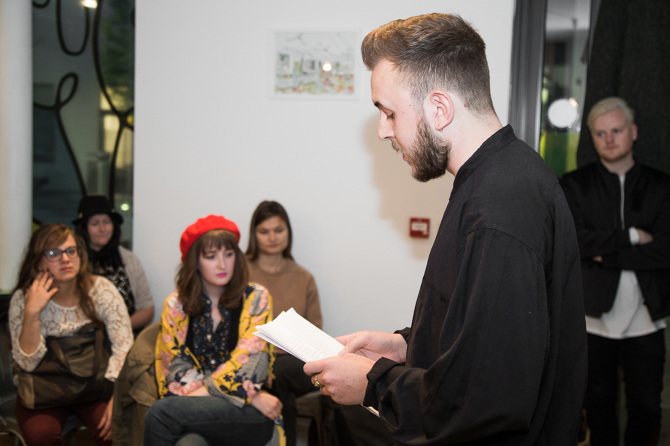
Decade Zero: Art in Climate Action opening performance
How will this project move forward beyond the exhibition to address the need for an ongoing conversation on climate change in culture and in the wider community?
BY: An important factor is to have our project well documented online in order to contribute to the research and discussions of artists and activists. That is why participating in interviews like this is also beneficial for addressing the need for ongoing conversation.
Regarding this project, we want to further expand boundaries of the audience we can reach by organising site specific, public art exhibitions, as well as looking to collaborate more with other artists.
ZZ: One way to achieve this is by working towards an online community in order to share, network, and collaborate. We have a page on Facebook, Decade Zero: Environment and Art Matters, and will look to launch it at a larger scale soon.
BY: I would like to end by including this quote by Ken Saro-Wiwa for thought,
“You cannot have art for art's sake. This art must do something to transform the lives of a community, of a nation.”
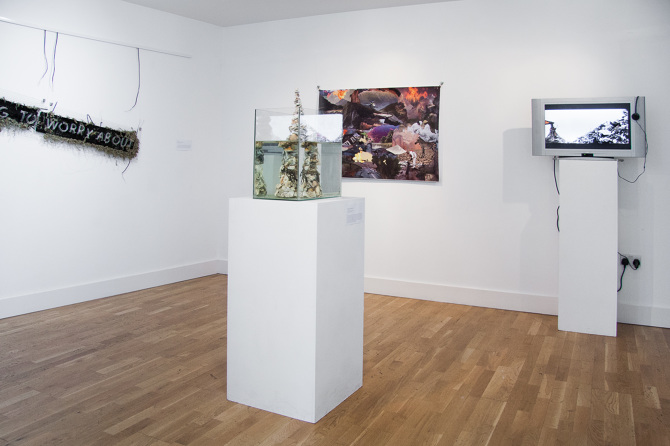
Decade Zero, exhibition view Greenwich West Gallery
---
All photographs and photo captions are provided by Ben Yau and Žaneta Zukalová
Decade Zero: Art in Climate Action at Greenwich West Community and Arts Centre
12 October - 18 October
Opening event: 5:30PM – 9PM on 12th October
Exhibition open 10AM – 6PM everyday (closed Sunday)
Free entry
---
Follow Decade Zero, Ben Yau and Žaneta Zukalová:
Decade Zero
Website: www.cargocollective.com/decadezero
Facebook: www.facebook.com/decadezero.environment
Ben Yau
Website: www.cargocollective.com/benyau
Žaneta Zukalová
Instagram: www.instagram.com/zaneta_seriously
Decade Zero: Art in Climate Action is an exhibition by Ben Yau and Žaneta Zukalová, whose works approach the role of art amongst the sociopolitical tensions of petrocapitalism and global environmental deterioration. Addressing public, corporate and governmental agencies, the show tackles the broader challenges of varied responses and responsibilities to climate change. The project will expand online as Decade Zero: Environment and Art Matters, and Worm’s meets up with Ben and Žaneta to find out more.

Decade Zero, exhibition view Greenwich West Gallery
Decade Zero: Art in Climate Action positions art as an activistic negotiator between the public and governmental understanding of the climate crisis. How do you define the parameters and scope of political art, its responses or responsibilities, to act against global environmental collapse?
Žaneta Zukalová: Art has the power to coherently articulate and visualise environmental issues to the public. Through aesthetic means, it can be appealing enough to engage people with such dense and intensive topics such as fossil fuels industry, ocean acidification etc. Although there is no doubt that climate scientists have a deeper knowledge of their research and study, artists can take and translate this research into a visual language that is easier for people to understand.

Ben Yau and Zaneta Zukalova
Acid Tank, 2017
Glass tank, sea shells, acidified water Approx 450 x 430 x 260 mm
However, political/activist artworks often tend not to be specific enough in terms of their appearance, and thus, unless it is studied, the artwork loses its capacity to explain, educate and inspire. To give an example, the concepts of Felix Gonzales-Torres’s art are extremely interesting, elaborate, and sociologically important to address, but whom is it actually for? If you choose to convey the topic of social injustice, should it be not serving a wider society rather than a limited circle of people already familiar with the topic or coming from the sphere of art? We want to contribute in order to spread the notion of community action. So the vision is to educate people and make them aware of the power they hold together as a community; to act and to change what is needed in order to make the world work better.
On the other hand, Joseph Beuys’s political engagement was indisputably one of the most visible and straightforward within the artworld. He managed to interact with people in a comprehensive and effective manner. He talked to his audience in person, discussing politics and possible solutions to various social injustices. His message was clear, radical and inspiring and that is what our aim is as well.

Ben Yau and Zaneta Zukalova
Acid Tank, 2017
Glass tank, sea shells, acidified water Approx 450 x 430 x 260 mm
Ben Yau: There are boundaries to what political art can and cannot achieve to act against such injustices as global environmental collapse. As we can learn from the political art produced by artists in response to the Vietnam War in the 1960s, or the numerous collectives who sparked action against the AIDs crisis in the 1980s, political art can be argued to be a catalyst to real change, by sparking political action. However – to borrow an idiom from the collective, Gran Fury – in many ways, “art is not enough”. Political art, as opposed to activist art, exists in physicality within an art institution, and therefore, adopts or even promotes the deficiencies that come from many of these institutions.
For example, art galleries mostly are, and largely have always been, exclusionary and elite spaces. What came as a realisation to me was that many art galleries do a pretty dire job of inviting the community that they exist within, as Zaneta already mentioned. And of course we must consider the funding that British museums receive from the fossil fuels industry. How can artists challenge extractivism within such institutions, when they so heavily cherish the oil money that they receive? Beyond this, how can artists challenge neoliberal ideas within institutions if they rely on funding from multinational corporations? There are many reasons to oppose arts funding from fossil fuels, but one reason that is not discussed enough is that it impairs artists’ abilities to challenge such industries.

Zaneta Zukalova
Evolve and Destroy, 2017 Inkjet print
841 x 1189mm
Despite the challenges for artists in the current climate, we discovered ways to circumnavigate these issues. For example, what we realised when seeking a space to host our exhibition is that an inclusive, public community and art centre such as Greenwich West was a more appropriate environment than a large or commercial gallery. We also consciously elaborated on the artworks by placing contextual descriptions on labels in plain English, in order for visitors, many of whom will not have art or philosophy degrees, to benefit from the artwork. Such creative solutions can be viewed as artistically distasteful to some, but it is up to contemporary artists to challenge the status quo in order to improve it.
How do the artworks in the exhibition engage with the multifaceted subject, from climate science to cultural responses, policy-making to activist resistances?
BY: All of the artworks go beyond only demonstrating environmental damage. From the beginning, we were aware of the frictions and correlations between deregulated markets and oil spills; domestic disasters and remote commercial practices; environmental policy and crony capitalism. We wanted to demonstrate many of these connections.

Ben Yau
Oil Spill, 2017
Oil based ink on laser printed paper 30 prints of 297 x 420 mm
One artwork, titled Oil Spill (2017), dominates a corner of the floor space, and confronts the viewer with thirty pages of market data collected from the Financial Times archive, that correspond by date to thirty oil spill events in the past five years. The artwork makes use of a traditional marbling technique of floating oil-based inks on top of water, with an alteration of using this printed market data instead of plain paper to capture the ink. In this way, the aqueous patterns created by the floating black ink “recreate” the oil spills, while becoming part of the base data material. By doing this, I wanted to convey that such disasters at frequency should not be viewed without considering the deregulated economic system that allows oil companies to extract. Just like the tragedy of Grenfell Tower, oil spills are largely avoidable disasters that are manifestations of corner cutting and penny saving, which is in turn integral to under-regulated industries.

Ben Yau
Oil Spill, 2017
Oil based ink on laser printed paper 30 prints of 297 x 420 mm
ZZ: Also, we wanted to point out the geographical proximity and near presence of climate change. For instance, in my work called Welcome Home (2017), I drew on the correlation between the fossil fuel industry and the notion of home. From gas fracking and its subsequent leak into the domestic water systems, to the compulsory purchase order of wetlands that the Sompeta people depend on for vital crops, fossil fuels can no longer be considered a remote problem. On the contrary, they have become a household issue globally. The most fragile and worst affected areas are still those near the coast such as Bangladesh, Sudan, Caribbean and Siberia, yet paradoxically they are the least responsible for carbon emissions. Welcome Home consists of a series of videos placed behind one-way mirror, depicting various environmental corruptions. It exploits the reflective act of looking into a mirror, thereby putting the spectator in the position of participant rather than passive observer.

Zaneta Zukalova
Welcome Home, 2017
Video, one way mirror, frame, monitor 594 x 841mm
You are also showing a short film "Forget Shorter Showers" by the artist and independent filmmaker Jordan Brown. What kind of political action does he call for and how does this perspective augment the discussions you hope the exhibition can stir?
BY: The film scrutinises and puts into perspective individualistic "solutions" to environmental issues such as composting or shorter showers, and articulates why it is not an alternative to real, political action.
ZZ: It also explains why the fossil fuels lobbyists want people think that these personal solutions are an effective way to deal with climate change, while disregarding the fact that carbon emissions from industry far outweigh the pollution caused by municipal use. The film uses the words of Kirkpatrick Sale, an independent scholar and author who has written about environmentalism and political decentralism:
For the past 15 years the story has been the same every year: individual consumption — residential, by private car, and so on — is never more than about a quarter of all consumption; the vast majority is commercial, industrial, corporate, by agribusiness and government [he forgot military]. So, even if we all took up cycling and wood stoves it would have a negligible impact on energy use, global warming and atmospheric pollution.
Finally, the film provides alternative and real solutions, which it sees in collective direct action, such as organising, protesting, and lobbying.
BY: I would like to add to this by highlighting the importance of systemic change through environmental policy. When discussing solutions to climate change with a friend, they brought up some recent research into how dispersing crushed up diamonds into the sky could reflect light and heat away from the Earth. What was amazing to me was that, to this intelligent individual, shooting diamond dust into the sky was somehow more feasible than divesting from fossil fuels and introducing a tax on carbon emissions. It conveys the sheer lack of optimism we can have when it comes to challenging the neoliberal system; we can sooner imagine a blanket of diamonds in our stratosphere than reasonable measures that detract and divest from corporate interests.

Ben Yau
NOTHING TO WORRY ABOUT, 2017
Acrylic tubing, perspex sheet, steel mesh, moss Dimensions variable
Decade Zero opened with a diverse programme of expression on environmental issues, including a talk, film screening, poetry and sound performances. Tell us more about this event and how they inform the various concepts of the exhibition.
BY: Once we established a time and place for the exhibition opening, we decided to put out an open call for performers addressing many of the issues discussed. An important factor was to have voices from a diverse range of backgrounds as well as a multi-disciplined approach.
ZZ: To be exact, we had six performers, all reflecting on climate change from a different perspective: Brandon Ra Pestano read out a few of his poems where he made a point on the relation of capitalism to the environment. Caleb Adebayo, a lawyer and founder of an environmental nonprofit Earthplus in Nigeria sent us his video response to the issue of climate change from the point of view of local people, who are one of the worst afflicted. Sophie Marsh and Leo May contributed with a short film Americas exploring the ‘the emotional and physical consequences of our disassociation with nature’. We included two artists who use music as their means: sound artist Luc Wilkinson created a special piece corresponding to our exhibition and Chris Wilson played three songs reflecting on the correlation of changing climate – changing society. Scientist and science communicator Dr. Lyle Zimmerman gave us a very comprehensive and striking talk on the issue of ocean deoxygenation. Overall, it was an engaging and diverse set of performances uniting like-minded people from various artistic fields together.

Decade Zero: Art in Climate Action opening performance
How will this project move forward beyond the exhibition to address the need for an ongoing conversation on climate change in culture and in the wider community?
BY: An important factor is to have our project well documented online in order to contribute to the research and discussions of artists and activists. That is why participating in interviews like this is also beneficial for addressing the need for ongoing conversation.
Regarding this project, we want to further expand boundaries of the audience we can reach by organising site specific, public art exhibitions, as well as looking to collaborate more with other artists.
ZZ: One way to achieve this is by working towards an online community in order to share, network, and collaborate. We have a page on Facebook, Decade Zero: Environment and Art Matters, and will look to launch it at a larger scale soon.
BY: I would like to end by including this quote by Ken Saro-Wiwa for thought,
“You cannot have art for art's sake. This art must do something to transform the lives of a community, of a nation.”

Decade Zero, exhibition view Greenwich West Gallery
---
All photographs and photo captions are provided by Ben Yau and Žaneta Zukalová
Decade Zero: Art in Climate Action at Greenwich West Community and Arts Centre
12 October - 18 October
Opening event: 5:30PM – 9PM on 12th October
Exhibition open 10AM – 6PM everyday (closed Sunday)
Free entry
---
Follow Decade Zero, Ben Yau and Žaneta Zukalová:
Decade Zero
Website: www.cargocollective.com/decadezero
Facebook: www.facebook.com/decadezero.environment
Ben Yau
Website: www.cargocollective.com/benyau
Žaneta Zukalová
Instagram: www.instagram.com/zaneta_seriously


